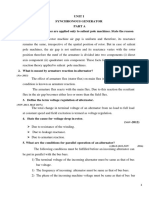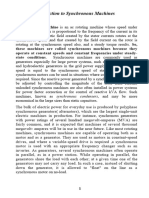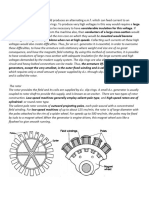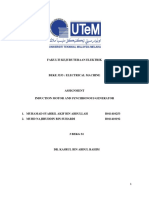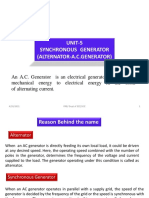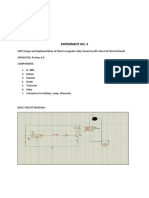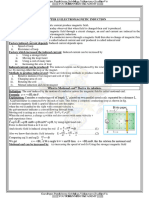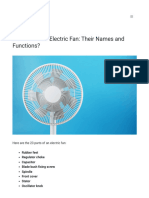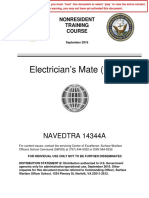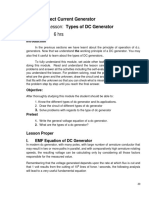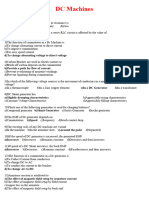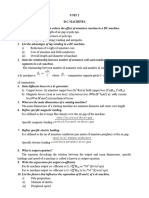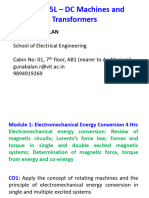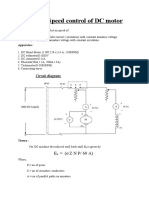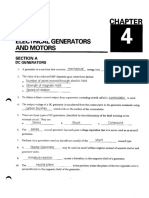Synchronous generator
Synchronous generator is a synchronous machine which converts mechanical power into AC
electric power through the process of electromagnetic induction. Synchronous generators are also
referred to as alternators or AC generators. The term "alternator" is used since it produces AC
power. It is called synchronous generator because it must be driven at synchronous speed to
produce AC power of the desired frequency. They are widely used at power plants.
Construction:
As alternator consists of two main parts:
Stator – The stator is the stationary part of the alternator. It carries the armature winding
in which the voltage is generated. The output of the alternator is taken form the stator.
Rotor – The rotor is the rotating part of the alternator. The rotor produces the main field
flux.
Stator Construction of Alternator
The stator of the alternator includes several parts, viz. the frame, stator core, stator or armature
windings, and cooling arrangement.
The stator frame may be made up of cast iron for small-size machines and of welded steel
for large-size machines.
The stator core is assembled with high-grade silicon content steel laminations. These
silicon steel laminations reduce the hysteresis and eddy-current losses in the stator core.
The slots are cut on the inner periphery of the stator core. A 3-phase armature winding is
put in these slots.
The armature winding of the alternator is star connected. The winding of each phase is
distributed over several slots. When current flows through the distributed armature
winding, it produces an essential sinusoidal space distribution of EMF.
�Rotor Construction of Alternator
The rotor of the alternator carries the field winding which is supplied with direct current through
two slip rings by a separate DC source (also called exciter). The exciter is generally a small DC
shunt generator mounted on the shaft of the alternator.
For the alternator, there are two types of rotor constructions are used viz. the salient-pole type
and the cylindrical rotor type.
Salient Pole Rotor
The term salient means projecting. Hence, a salient pole rotor consists of poles projecting out
from the surface of the rotor core. This whole arrangement is fixed to the shaft of the alternator
as shown in the figure. The individual field pole windings are connected in series such that when
the field winding is energised by the DC exciter, the adjacent poles have opposite polarities.
The salient pole type rotor is used in the low and medium speed (from 120 to 400 RPM)
alternators such as those driven by the diesel engines or water turbines because of the following
reasons −
The construction of salient pole type rotor cannot be made strong enough to withstand the
mechanical stresses to which they may be subjected at higher speed.
� If the salient field pole type rotor is driven at high speed, then it would cause windage
loss and would tend to produce noise.
Low speed rotors of the alternators possess a large diameter to provide the necessary space for
the poles. As a result, the salient pole type rotors have large diameter and short axial length.
Cylindrical Rotor
The cylindrical rotors are made from solid forgings of high-grade nickel-chrome-molybdenum
steel.
The construction of the cylindrical rotor is such that there are no-physical poles to be
seen as in the salient pole rotor.
In about two-third of the outer periphery of the cylindrical rotor, slots are cut at regular
intervals and parallel to the rotor shaft.
The field windings are placed in these slots and is excited by DC supply. The field
winding is of distributed type.
The unslotted portion of the rotor forms the pole faces.
It is clear from the figure of the cylindrical rotor that the poles formed are non-salient,
i.e., they do not project out from the rotor surface.
The cylindrical type rotor construction is used in the high-speed (1500 to 3000 RPM) alternators
such as those driven by steam turbines because of the following reasons −
The cylindrical type rotor construction provides a greater mechanical strength and
permits more accurate dynamic balancing.
It gives noiseless operation at high speeds because of the uniform air gap.
The flux distribution around the periphery of the rotor is nearly a sine wave and hence a
better EMF waveform is obtained.
A cylindrical rotor alternator has a comparatively small diameter and long axial length. The
cylindrical rotor alternators are called turbo-alternators or turbo-generators. The alternator
with cylindrical rotor has always horizontal configuration installation.
�Working Principle and Operation of Alternator
An alternator or synchronous generator works on the principle of electromagnetic induction, i.e.,
when the flux linking a conductor changes, an EMF is induced in the conductor. When the
armature winding of alternator subjected to the rotating magnetic field, the voltage will be
generated in the armature winding.
When the rotor field winding of the alternator is energised from the DC exciter, the alternate N
and S poles are developed on the rotor. When the rotor is rotated in the anticlockwise direction
by a prime mover, the armature conductors placed on the stator are cut by the magnetic field of
the rotor poles. As a result, the EMF is induced in the armature conductors due to
electromagnetic induction. This induced EMF is alternating one because the N and S poles of the
rotor pass the armature conductors alternatively.
The direction of the generated EMF can be determined by the Fleming’s right rule and the
frequency of it is given by:
𝑁𝑠 𝑃
𝑓=
120
Where, Ns is the synchronous speed in RPM and P is the number of rotor poles.
The magnitude of the generated voltage depends upon the speed of rotation of the rotor and the
DC field excitation current. For the balanced condition, the generated voltage in each phase of
the winding is the same but differ in phase by 120° electrical.
DC Excitation of Synchronous Generator
As we discussed that the synchronous generator is not a self-start machine. It must
connect with the external source.
To excitation of the generator, the DC supply is connected with the circuitry of the rotor.
As the rotor rotates so there is some precaution that we should keep in mind, connecting
rotor with the DC source.
o Try to connect the windings of the rotor with the DC source through the slip ring
and graphite made brushes, if we connect the windings directly with the dc
source, it causes serious spark and motor will damage.
o Connect such dc source with the generator that remains permanently connected
with the rotor.
The slip ring is rings made by some metal, they are mounted on the shaft of the generator
and have some insulation.
Every end of the rotor’s windings is joined with the slip rings and the static brushes are
mounted on the slip rings.
The brushes always mounted on the slip ring because they are made from graphite which
has less resistance.
� If the one terminal of the DC source is joined with one carbon brush, then the other will
be connected with the second brush.
The important thing you should note that the dc voltage you provided to the generator
should have same value irrespective of the variation in the speed and angular position of
the generator.
Problems of Slip Ring and Brushes in Synchronous Generator
As we discussed that we use slip ring and carbon brushes to provide the dc supply to the
windings of the rotor. These two components cause some difficulties.
As the brush is made from the carbon that is soft material nature, so their condition must
be monitored after some time and maybe they should be replaced after some time. This
process increases the maintenance cost of the machine.
There is some loss of voltage at the brushes which increases the field current and power
loss at the field windings.
For a smaller synchronous machine this method of the voltage is used because it is a
cheap method for these machines.













